#and do maintenance ourselves
Explore tagged Tumblr posts
Text
To the Anon who told me about the cheesy bread recipe, thank you very much <3 I've prevented myself from starving multiple times because of you <3
#random rambles#I wanna try something#where we all share simple low maintenance recipes and have to try them#so in turn we make ourselves eat#I think I'm gonna do it
17 notes
·
View notes
Text
I'm working on a project on my computer and vaping, this is the closest I've been to my normal pain level in days. I know it won't last, especially not when I'm trying to sleep later.
Trying to ignore the guilt of disappearing from work for three days, when the last time I did that it was my mental breakdown two years ago.
#it's not like then#not really#I mean it is and it isn't#my physical health was/is in a point of decline and the fear of pushing myself too hard became/is becoming too much#but I've grown so much in the last two years#I'm not gonna lie#sometimes I wish I had quit the work force back then#I obviously couldn't have predicted the sharp decline of my physical health over the course of this calendar year#but it happened#so the day to day question becomes now what?#now what do I do with myself/my life/my time/my energy/my independence/my god knows what else#nothing I am physically capable of doing is going to fulfill me and the things that fulfill me are now out of reach#so what fucking now?#I think this is it folks#I think it's time to start planning my exit strategy from the work force#and I don't know how the fuck I'm gonna do that when we literally just bought a condo#and I have therapy tomorrow too so I get to try and relay all this to my therapist in just half an hour lol#I don't regret dropping down to maintenance sessions#but sometimes you just need more time#tomorrow I'll get on the phone and be like ohmygodjoshitsbeensuchafuckingweek#ihadaflareupsobadicalledoutofatotaloffourdaysofworkandleftearlybythreehoursoneday#andnowimhavingcompletefearsaboutbeingsocompletelyincapacitatedthatillneverleavethehouseagain#and he'll be like well first of all BREATHE#second of all there's nothing indicating that this is unlike every other flare up that you've managed to fight through after a week plus#and then I'll be like butwhatifimstuckhomewithkaren24/7andshedrivesmebatshitwhenicantleaveonmyown?#and then he'll be like what did I just say about breathing?#but then he'll point out that the point of us moving is so we can get more space and be able to separate ourselves from her more#and then I'll cycle back to but she won't see reason and take the downstairs bedroom now instead of god knows how long down the line#trust me we do this every two weeks lol
2 notes
·
View notes
Text
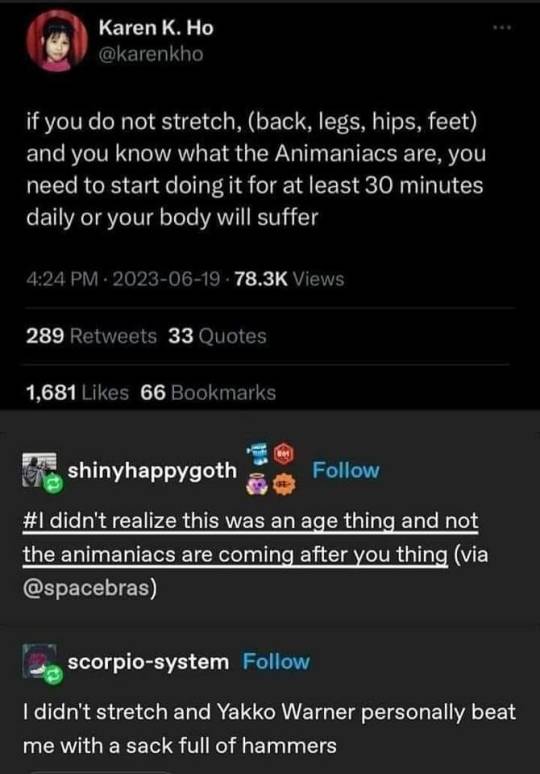
#animaniacs#meme#stretching#body maintenence#millenials#yakko warner#jokes aside#body maintenance is really important#me and my partner have made a concerted effort to start taking better care of ourselves this year#we're not trying to get skinny or get swole or anything related to appearance#we've watched our parents go through so many struggles with loss of mobility and other age related health issues#it really made us see that you only get one body and you can't take your health for granted#we started exercising regularly#exercise has so many benefits beyond how you look#I don't think my appearance has even changed much but I feel more capable#I have more stamina my back pain and joint stiffness is nearly gone and I'm much more flexible#I think 30 minutes of stretching is a bit much for most people but we do at least 10 minutes after each workout#every other day we tell each other how grateful we are that we're taking better care of ourselves#we feel so much better and doing anything is at least 15% easier#I just don't want aging to be painful#I don't necessarily like exercising but a good pair of headphones with music and audiobooks and youtube can make a world of difference#I never thought I'd be a gym rat but here we are#bodies are meant to move#also why are we like the only people at the gym to ever take time to stretch?#do other people lift weights and then just put up with being sore?#I'd rather not feel sore after exercising#plus stretching is a great way to cool down and improve your flexibility#health over thinness
3 notes
·
View notes
Text
i love the maintenance guy in my apt he said he's not legally allowed to move tenants' stuff to get to where he needs to but he knows my joints and muscles are fucked and was like "you didn't see me do this- I'm tired of watching you struggle" and moved the stuff for me
#he is a very nice maintenance guy#we always get the same guy bc he's the only one employed here who can communicate with my deaf mother#and he's really chill he fixes things that the landlord says doesn't need fixing and gives good advice on how to do things ourselves
1 note
·
View note
Text
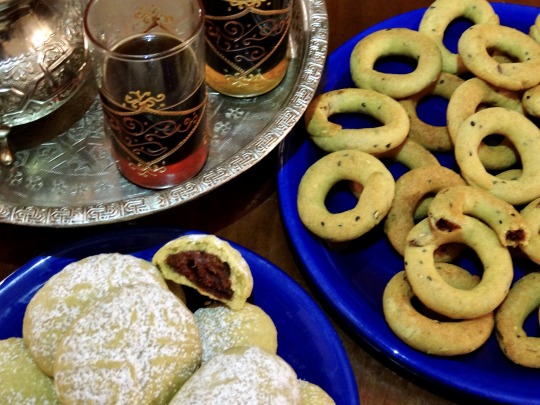
[ID: Two plates of cookies, one oval and topped with powdered sugar, and the others shaped in rings; one cookie is broken in half to show a date filling; two glasses of coffee on a silver tray are in the background. End ID]
معمول فلسطيني / Ma’moul falastini (Palestinian semolina cookies)
Ma’moul (also transliterated “ma’amoul,” “maamoul” and “mamoul”) are sweet pastries made with semolina flour and stuffed with a date, walnut, or pistachio filling. The cookies are made tender and crumbly with the addition of fat in the form of olive oil, butter, or clarified butter (سمن, “samn”); delicate aromatics are added by some combination of fennel, aniseed, mahlab (محلب: ground cherry pits), mastic gum (مستكه, “mistīka”), and cinnamon.
“مَعْمُول” means “made,” “done,” “worked by hand,” or “excellently made” (it is the passive participle of the verb “عَمِلَ” “‘amila,” "to do, make, perform"). Presumably this is because each cookie is individually filled, sealed, and shaped by hand. Though patterned molds known as طوابع (“ṭawābi’,” “stamps”; singular طابع, “ṭābi’”) are sometimes used, the decorations on the surface of the cookies may also be applied by hand with the aid of a pair of small, specialized tongs (ملقط, “milqaṭ”).
Because of their laborious nature, ma’moul are usually made for feast days: they are served and shared for Eid, Easter, and Purim, a welcome reward after the Ramadan or Lenten fasts. For this reason, ma’moul are sometimes called “كَعْك العيد” (“ka’k al-’īd,” “holiday cakes”). Plates of the cookies, whether homemade or store-bought, are passed out and traded between neighbors in a practice that is part community-maintenance, part continuity of tradition, and part friendly competition. This indispensable symbol of celebration will be prepared by the women of a family even if a holiday falls around the time of a death, disaster, or war: Palestinian food writer Laila El-Haddad explains that "For years, we endured our situation by immersing ourselves in cooking, in our routines and the things we could control."
Other names for these cakes exist as well. Date ma’moul–the most common variety in Palestine–may be called كَعْك بعَجْوَة (“ka'k b'ajwa”), “cakes with date paste.” And one particular Palestinian variety of ma’moul, studded with sesame and nigella seeds and formed into a ring, are known as كَعْك أَسَاوِر (“ka'k 'asāwir”), “bracelet cakes.” The thinner dough leads to a cookie that is crisp and brown on the outside, but gives way to a soft, chewy, sweet filling.
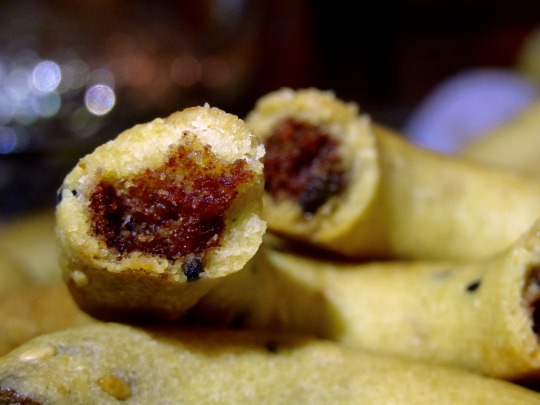
[ID: An extreme close-up on one ka'k al-aswar, broken open to show the date filling; ma'moul and a silver teapot are very out-of-focus in the background. End ID]
History
Various sources claim that ma’moul originated in Egypt, with their ancestor, كحك (kaḥk), appearing in illustrations on Pharaonic-era tombs and temples. The more specific of these claims usually refer to “temples in ancient Thebes and Memphis,” or more particularly to the vizier Rekhmire’s tomb in Thebes, as evidencing the creation of a pastry that is related to modern kahk. One writer attests that this tomb depicts “the servants mix[ing] pure honey with butter on the fire,” then “adding the flour by mixing until obtaining a dough easy to transform into forms” before the shaped cookies were “stuffed with raisins or dried dates and honey.” Another does not mention Rekhmire, but asserts that “18th-dynasty tombs” show “how honey is mixed with butter on fire, after which flour is added, turning the substance into an easily-molded dough. These pieces are then put on slate sheets and put in the oven; others are fried in oil and butter.”
Most of these details seem to be unfounded. Hilary Wilson, summarizing the state of current research on Rekhmire’s tomb, writes that the depicted pastries were delivered as an offering to the Treasury of the Temple of Amun; that they certainly contained ground tiger nuts; that they presumably contained wheat or durum flour, since ground tiger nuts alone would not produce the moldable dough illustrated; that the liquid added to this mixture to form the dough cannot be determined, since the inscription is damaged; that the cakes produced “are clearly triangular and, when cooked are flat enough to be stacked” (any appearance that they are pyramidal or conical being a quirk of ancient Egyptian drawing); that they were shallow-fried, not cooked in an oven; and that honey and dates are depicted at the far left of the scene, but their relationship to the pastries is unclear. There is no evidence of the honey being included in the dough, or the cookies being stuffed with dates; instead, Wilson speculates that “It appears that the cooks are preparing a syrup or puree of dates and honey. It is tempting to think that the cakes or pastries were served [...] with a generous portion of syrup poured over them.” Whether there is any direct lineage between these flat, fried pastries and the stuffed, molded, and baked kahk must also be a matter of speculation. [1]
Another origin claim points to ancient Mesopotamia. James David Audlin speculates that ma’moul are "possibly" the cousins of hamantaschen, both being descended from the molded "kamānu cakes that bore the image of [YHWH’s] goddess wife Inanna [also known as Ishtar or Astarte]" that were made in modern-day Syria. Other claims for Mesopotamia cite qullupu as the inspiration: these cakes are described in the contemporary record as wheat pastries filled with dates or raisins and baked. (Food historian Nawal Nasrallah writes that these cookies, which were offered to Ishtar for the new year festival in spring, may also be an origin point for modern Iraqi كليچة, "kleicha.")
The word "määmoul" had entered the English language as a type of Syrian farina cake by 1896.
In Palestine
From its earliest instantiations, Zionist settlement in Palestine was focused on building farming infrastructure from which Palestinians could be excluded: settlers, incentivized by foreign capital, aimed at creating a separate economy based around farms, agricultural schools, communal settlements, and research institutions that did not employ Arabs (though Arab labor and goods were never entirely cut out in practice).
Zionist agricultural institutes in Palestine had targeted the date as a desirable crop to be self-sufficient in, and a potentially profitable fruit for export, by the 1930s. Ben-Zion Israeli (בנציון ישראלי), Zionist settler and founder of the Kinneret training farm, spoke at a 1939 meeting of the Organization of Fruit Growers (ארגון מגדלי פירות) in the Nahalel (נהלל) agricultural settlement to discuss the future of date palms in the “land of Israel.” He discussed the different climate requirements of Egyptian, Iraqi, and Tunisian cultivars—and which among them seemed “destined” (נועדים) for the Jordan Valley and coastal plains—and laid out his plan to collect saplings from surrounding countries for planting despite their prohibitions against such exports.
In the typical mode of Zionist agriculture discourse, this speech dealt in concepts of cultivation as a means of coming into a predestined ownership over the land; eating food suited for the climate as a means of belonging in the land; and a return to Biblical history as a triumphant reclamation of the land from its supposed neglect and/or over-cultivation by Palestinian Arabs over the past 2,000 years. Israeli opened:
נסתכל לעברה של הארץ, אשר אנו רוצים להחיותה ולחדשה. היא השתבחה ב"שבעה מינים" ואלה עשוה אינטנסיבית וצפופת אוכלוסין. לא רק חיטה ושעורה, כי אם גם עצים הנותנים יבול גדול בעל ערך מזוני רב. בין העצים -- הזית [...] הגפן, התאנה והתמר. לשלושה מהם, לזית, לתאנה ולתמר חטאה התישבותנו שאין היא נאחזת בהם אחיזה ציםכר של ממש ואינה מפתחת אותם דים.
We will look to the past of the land [of Israel], which we want to revive and renew. It excelled in "seven species," and these flourished and became densely populated. Not only wheat and barley, but also trees that give a large and nutritious crop. Among the trees: the olive, [...] the vine, the fig and the date. For three of them, the olive, the fig and the date, it is the sin of our settlement that it does not hold on to them with a strong grip and does not develop them.
He continued to discuss the benefits of adopting the date—not then part of the diet of Jewish settlers—to “health and economy” (בריאות וכלכלה). Not only should the “land of Israel” become self-sufficient (no longer importing dates from Egypt and Iraq), but dates should be grown for export to Europe.
A beginning had already been made in the importation of about 8,000 date palm saplings over the past two decades, of which ¾ (according to Israeli) had been brought by Kibbutz Kinneret, and the remaining ¼ by the settlement department of the Zionist Commission for Palestine (ועד הצירים), by the Mandate government's agriculture department, and by people from Degania Bet kibbutz ('דגניה ב). The majority of these imports did not survive. More recently, 1000 smuggled saplings had been planted in Rachel’s Park (גן רחל), in a nearby government plot, and in various places in the Jordan Valley. Farms and agricultural institutions would need to collaborate in finding farmers to plant dates more widely in the Beit-Sha’an Valley (בקעת בית שאן), and work to make dates take their proper place in the settlements’ economies.
These initial cuttings and their descendents survive in large plantations across “Israel” and the occupied Palestinian territories. Taher Herzallah and Tarek Khaill write that “Palm groves were planted from the Red Sea in the south along the Dead Sea, and as far as the Sea of Galilee up north, which has given the Israeli date industry its nickname ‘the industry of the three seas’” Since Israel occupied the Palestinian West Bank in 1967, it has also established date plantations in its illegal settlements in that portion of the Jordan Valley.” Today, these settlements produce between 40 and 60% of all Israeli dates.
In 2022, Israel exported 67,042 tons of dates worth $330.1 million USD; these numbers have been on a steady rise from 4,909 tons worth $1.2m. in 1993. Palestinian farmers and their children, disappropriated from their land and desperate for income, are brought in to date plantations to work for long hours in hazardous conditions for low pay. Workers are lifted into the date palms by cranes where they work, with no means of descending, until the crane comes to lower them down again at the end of the day. Injuries from falls, pesticides, heat stroke, and date-sorting machinery are common.
Meanwhile, settlers work to curtail and control Palestinian production of dates. The Palestinian population in the West Bank and Gaza is used as a pool of cheap labor and a captive market to purchase Israeli imports, absorb excesses in Israeli goods, stabilize Israeli wages, and make up for market deficits. Thus Palestinian date farmers may be targeted with repressive measures such as water contamination and diversion, destruction of wells, crop destruction, land theft, military orders forbidding the planting of trees, settler attacks, closing of checkpoints and forbidding of exports, and the denial of necessary equipment or the means to make it, in part to ensure that their goods do not compete with those of Israeli farmers in domestic or foreign markets. Leah Temper writes that these repressive measures are part of a pattern whereby Israel tries to “stop [Palestinian] growth in high value crops such as strawberries, avocados and dates, which are considered to be ‘Israeli Specialties’.”
At other times, Palestinian farmers may be ordered to grow certain crops (such as strawberries and dates), and forbidden to grow anything else, when Israeli officials fear falling short of market demand for a certain good. These crops will be exported by Israeli firms, ensuring that the majority of profits do not accrue to Palestinians, and that Palestinians will not have the ability to negotiate or fulfill export contracts themselves. Nevertheless, Palestinian farmers continue to defy these oppressive conditions and produce dates for local consumption and for export. Zuhair al-Manasreh founded date company Nakheel Palestine in 2011, which continues production despite being surrounded by Israeli settlements.
Boycotts of Israeli dates have arisen in response to the conditions imposed on Palestinian farmers and workers. Herzallah and Khaill cite USDA data on the effectiveness of boycott, pressure, and flyering campaigns initiated by groups including American Muslims for Palestine:
Israel’s exports of dates to the US have dropped significantly since 2015. Whereas 10.7 million kilogrammes (23.6 million pounds) of Israeli dates entered the US market in 2015-2016, only 3.1 million kilogrammes (seven million pounds) entered the US market in 2017-2018. The boycott is working and it is having a detrimental effect on the Israeli date industry.
Date products may not be BDS-compliant even if they are not labeled as a product of Israel. Stores may repackage dates under their own label, and exporters may avoid declaring their dates to be a product of Israel, or even falsely label them as a product of Palestine, to avoid boycotts. Purchase California dates, or dates from a known Palestinian exporter such as Zaytoun or Yaffa (not “Jaffa”) dates.
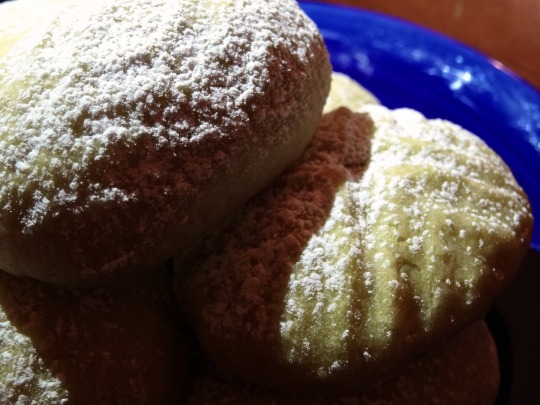
[ID: Close-up of the top of ma'moul, decorated with geometric patterns and covered in powdered sugar, in strong light and shadow. End ID]
Elsewhere
Other efforts to foreground the provenance and political-economic context of dates in a culinary setting have been made by Iraqi Jew Michael Rakowitz, whose store sold ma’moul and date syrup and informed patrons about individual people behind the hazardous transport of date imports from Iraq. Rakowitz says that his project “utilizes food as a point of entry and creates a different platform by which people can enter into conversation.”
[1] Plates from the tomb can be seen in N. de G. Davies, The tomb of Rekh-mi-Rē at Thebes, Vol. II, plates XLVII ff.
Purchase Palestinian dates
Donate to evacuate families from Gaza
Flyer campaign for eSims
Ingredients:
Makes 16 large ma'moul and 32 ka'k al-aswar; or 32 ma'moul; or 64 ka'k al-aswar.
For the dough:
360g (2 1/4 cup) fine semolina flour (سميد ناعم / طحين فرخة)
140g (1 cup + 2 Tbsp) white flour (طحين ابيض)
200g (14 Tbsp) margarine or vegetarian ghee (سمن), or olive oil
2 Tbsp (15g) powdered sugar
1 1/2 Tbsp (10g) dugga ka'k (دقة كعك)
1/2 tsp (2g) instant yeast
About 2/3 cup (190mL) water, divided (use milk if you prefer)
1 tsp toasted sesame seeds (سمسم)
1 tsp toasted nigella seeds (قزحه / حبة البركة)
Using olive oil and water for the fat and liquid in the dough is more of a rural approach to this recipe; ghee and milk (or milk powder) make for a richer cookie.
To make the bracelets easy to shape, I call for the inclusion of 1 part white flour for every 2 parts semolina (by volume). If you are only making molded cookies and like the texture of semolina flour, you can use all semolina flour; or vary the ratio as you like. Semolina flour will require more added liquid than white flour does.
For the filling:
500g pitted Madjoul dates (تمر المجهول), preferably Palestinian; or date paste
2 Tbsp oil or softened margarine
3/4 tsp dugga ka'k (دقة كعك)
3/4 tsp ground cinnamon
5 green cardamom pods, toasted, skins removed and ground; or 1/4 tsp ground cardamom
Small chunk nutmeg, toasted and ground, or 1/4 tsp ground nutmeg
10 whole cloves, toasted and ground, or 1/4 tsp ground cloves
The filling may be spiced any way you wish. Some recipes call for solely dugga ka'k (or fennel and aniseed, its main components); some for a mixture of cinnamon, cardamom, nutmeg, and/or cloves; and some for both. This recipe gives an even balance between the pungency of fennel and aniseed and the sweet spiciness of cinnamon and cloves.
Palestinian date brands include Ziyad, Zaytoun, Hasan, and Jawadir. Palestinian dates can also be purchased from Equal Exchange. You can find them online or at a local halal market. Note that an origin listed as "West Bank" does not indicate that a date company is not Israeli, as it may be based in a settlement. Avoid King Solomon, Jordan River, Mehadrin, MTex, Edom, Carmel Agrexco, Arava, and anything marked “exported by Hadiklaim”. Also avoid supermarket brands, as the origin of the dates may not be clearly marked or may be falsified to avoid boycots.
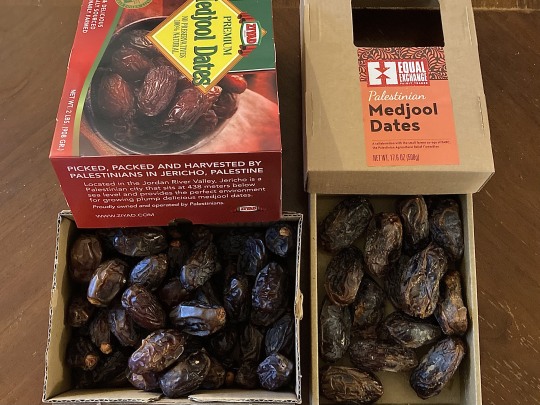
Instructions:
For the dough:
1. Melt margarine in a microwave or saucepan. Measure flours into a large mixing bowl and pour in margarine; mix thoroughly to combine. Rub flours between your hands for a few minutes to coat the grains in margarine. The texture should resemble that of coarse sad. Refrigerate the mixture overnight, or for up to 3 days.

2. Add dry ingredients to dough. If making both molded ma'moul and ka'k al-aswar, split the dough in half and add sesame and nigella seeds to one bowl.
3. Add water to each dough until you get a smooth dough that does not crack apart when formed into a ball and pressed. Press until combined and smooth, but do not over-knead—we don't want a bready texture. Set aside to rest while you make the filling.
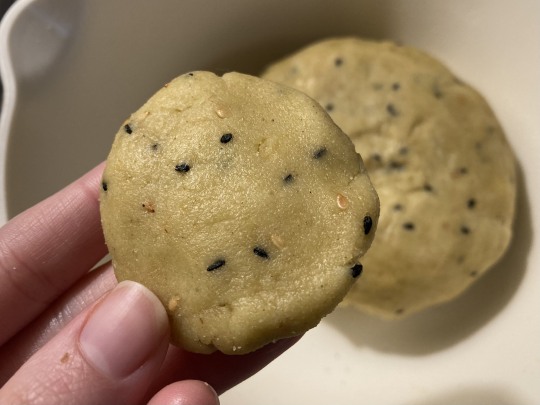
For the filling:
1. Pit dates and check the interiors for mold. Grind all ingredients to a paste in a food processor. You may need to add a teaspoon of water, depending on the consistency of your dates.
To shape the cookies:
Divide the filling in half. One half will be used for the ma'moul, and the other half for the bracelets.
For the ma'moul:
1. With wet hands, pinch off date filling into small chunks about the size of a walnut (13-16g each, depending on the size of your mold)—or roll filling into a long log and divide into 16-20 even pieces with a dough scraper. Roll each piece of filling into a ball between your palms.
2. Divide the dough (the half without seeds) into the same number of balls as you have balls of filling, either using a kitchen scale or rolling into a log and cutting.
3. Form the dough into a cup shape. Place a ball of filling in the center, and fold the edges over to seal. Press the dough into a floured ma'moul mold to shape, then firmly tap the tip of the mold on your work surface to release; or, use a pair of spiked tweezers or a fork to add decorative designs by hand.

4. Repeat until all the the dough and filling has been used, covering the dough you're not working with to keep it from drying out. Place each cookie on a prepared baking sheet.
For the ka'k al-aswar:
1. With wet hands, divide the date filling into about 32 pieces (of about 8g each); they should each roll into a small log about the size of your pinkie finger.
2. Divide the dough (the half with the seeds) into as many pieces as you have date logs.
3. Take a ball of dough and flatten it into a thin rectangle a tiny bit longer than your date log, and about 3 times as wide. Place the date log in the center, then pull the top and bottom edges over the log and press to seal. Seal the ends.
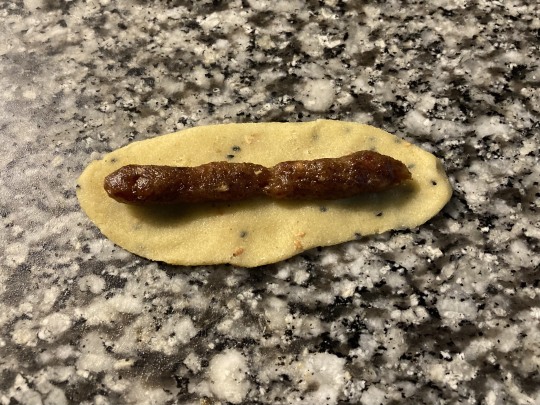
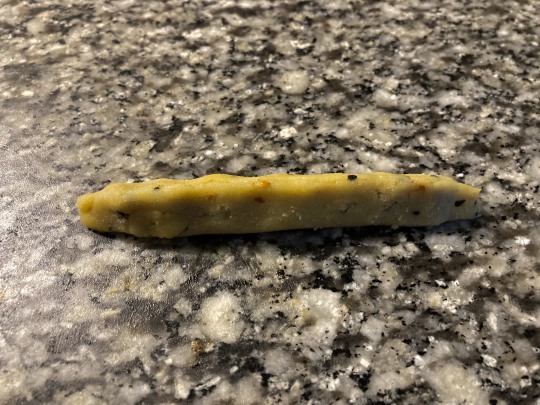
4. Roll the dough log out again to produce a thin, long rope a little bit thinner at the very ends than at the center. Press one side of the rope over the other to form a circle and press to seal.
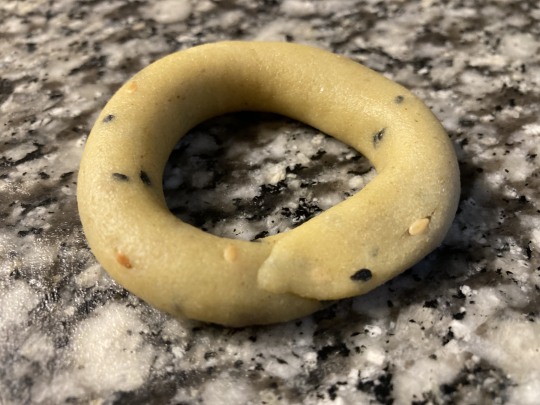
5. Repeat until all the the dough and filling has been used, covering the dough you're not working with to keep it from drying out. Place each cookie on a prepared baking sheet.
To bake:
1. Bake ma'moul at 350 °F (175 °C) in the center of the oven for about 20 minutes, until very lightly golden brown. They will continue to firm up as they cool.
2. Increase oven heat to 400 °F (205 °C) and bake ka'k al-aswar in the top third of the oven for about 20 minutes, until golden brown.
Sprinkle cookies with powdered sugar, if desired. Store in an airtight container and serve with tea or coffee, or give to friends and neighbors.
394 notes
·
View notes
Note
I'm sure you have enough politics asks in your inbox to last you a lifetime so I'm gonna ask something only tangentially related. What have you been doing to give yourself a break from *gestures wildly* all of this? Personally, I've been bouncing between watching all of Jenna Marbles' old videos while also channeling my inner King Tut Kid and watching back to back Ancient Egyptian documentaries.
Ahaha. Well. Something like the following:
Talked to friends and family and told them that I love them and will help them get through this if I can;
Forced myself to get out of bed and answer work emails, even while it's snowing like crazy so I haven't actually gone into work, and am stuck in my essentially unheated apartment while writing angry emails to the leasing office;
(They sent maintenance today; once again, this did not fix the problem but I have been theoretically promised they will at some point actually do so);
(To which I say Ha and also We'll See About That);
Sat in my bedroom with the door closed and the space heater on and trying to remember to eat;
Forced myself not to look at any news or headlines (I fail at this occasionally, but deactivated my Bird App account so I won't be tempted to doomscroll; also fuck Elon Musk);
Tried to provide some scraps of comfort to people on This Here Ye Olde Tumblr Website;
Ordered a new Lego set because what the hell, nothing matters;
Also took apart an old Lego set so I can rebuild it;
Ordered a tripod for my phone so I can take a proper photo and renew my passport online, as I also suggest you do just in case;
Made flu/Covid/hepatitis B/MMR booster/tetanus booster vaccine appointments for tomorrow (even if I have to trudge out in the snow, ugh) because fuck RFK Jr. and we need to protect ourselves and others before public health becomes a shitshow;
Spent today finishing the design, manuscript formatting, and uploading for The Empire of Bones, my Big Fat Queer Epic Historical Fantasy Novel About Which I am Excited;
So as soon as it is approved, hopefully by tomorrow, you and/or my other followers will be able to purchase a copy and get to readin'. Yeeeee. Productivity. Or something.
70 notes
·
View notes
Text
Manifestelle


On a dream girl journey, we want to basically brainwash ourselves to be the best version of ourselves. One way to do that is watching specific content to curate that dream girl. One youtuber I’ve been loving is Manifestelle. Here are some notes I’ve been taking so far:
Broke men love to project their insecurities and negativity on you. Don’t let them have access to you.
You shouldn’t be friends with men. Men look better when they are seen with you. They need to invest in you if they are to be seen with you.
As a woman, you are valuable just by existing.
Listen with your ears, not your triggers.
De-centering men is centering yourself and your desires.
Don’t get mad, get paid.
Abolish low effort men, 💅
Men want the high maintenance.
Stop playing life on hard mode.
Use the patriarchy to your benefit.


#femininity#high value woman#leveling up#elegance#hypergamy#affluence#luxury#goals#level up#divine feminine#dream girl journey#dream girl#powerful woman#powerful women#manifestelle#manifestation#manifesting#say no to dust#youtube#spoiled trophy wife#spoiledblr#spoiled gf#spoiled girlie
540 notes
·
View notes
Text
if you choose to chain yourself next to the prisoner, you can survive what appears to be decades or even centuries without ever needing to eat or drink. if you get the "happy ending" after slaying the princess, you survive for so long afterwards that time loses all meaning. and yet, if you kill the nightmare, you starve to death eventually. why is that?
my suspicion is that it has something to do with our own awareness of our physical limitations.

as much as the princess is shaped by our perception of her, we are also shaped somewhat by our perception of ourselves. this is most obvious with the various voices, who seem to represent whatever trait was strongest in the previous chapter we played. but our perception comes up in a few other distinct moments, too. let's take the adversary for example.
and she does, too.
if you choose to fight the adversary, armed or unarmed, the stubborn will urge you to keep getting up, regardless of the narrator telling you you've died. you can survive death itself because you believe you can. pieces of you splattered on the walls, your organs hammered into a shape beyond recognition, your body a shambling, twitching mess - it doesn't matter. you keep getting up.
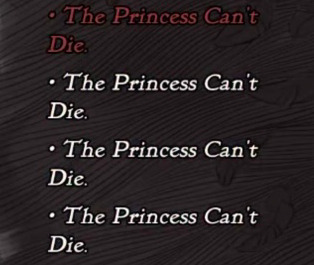
let's take the wild, as another example. if we reject the wild and turn inwards towards our fear/hatred, our unity with her unravels. as the narrator says, we remember we have a body. we stand on our two distinct feet once more, and encounter her, who is also a distinct, embodied creature. as much as her reality has changed, ours has too.
the prisoner doesn't starve. we don't experience anything physically unpleasant in her chapter if we chain ourselves up beside her. our awareness of our own biological reality and hers is next to nonexistent. but in the nightmare route?
the nightmare route is characterized by the paranoid's constant conscious maintenance of our autonomic nervous system. if he drops his concentration for even a second, the princess' presence will shut our organs down. we have never been aware of our own body more, and have also never believed more in its limitations. surviving biological failure seems like an impossibility. and so, it becomes one. we are only ever as embodied as we believe ourselves to be.

- the shifting mound, describing the shackled prisoner route
284 notes
·
View notes
Text
Look this is a feminism 105 topic and not a feminism 101 topic but we need to talk about. Self rape. The thing women do when we give a man we are in a relationship with sex when we don’t want to. Also known as maintenance sex. We need to call it what it is. Which is self rape. And it’s an interesting phenomenon because it shows the internalised misogyny we also have in believing we are sex objects that can provide this to men ‘unharmed’. And then years down the track. Our own bodies protest before our minds understand it. Our own bodies shut down the ability to self rape even without any feminist awareness or consciousness raising. It just happens and then women go … I don’t understand. It’s misogyny. It’s sexism. It’s harm to women.
Ofcourse rape by men is the most pressing topic. But I want to be able to talk about this phenomenon as well. It’s the infiltration of male values into female minds. It’s the absorbtion of patriarchal thought inflicting the idea of objectification so deep into our minds as women that we objectify ourselves into having sex we don’t want to have. And it’s hard to accept we might be offering ourselves up for rape but that is what this is. The rapist in our own minds.
#radfem#womens liberation#radfems do touch#radfem safe#radical feminism#radical feminists please interact#feminist#spinning#male violence
440 notes
·
View notes
Text
Lost housing and almost killed by our landlords
(Twice)

C*sh app: $dottybot
V*nmo: @dottybot
@translesbo's Paypal: [email protected]
My partner, @translesbo, and I after signing a lease, were put through 2 big gas leaks during times we had planned on and had been close to sleeping in the apartment. The entire time the place made us sick and was hard to breathe in with a strong awful smell and remained unihabitable, causing us to be without a home since July 3rd, 2023 due to it.
We are a brown latine lesbian couple and both trans (her transfem and myself tme cafab) and autistic along with other disabilities, and have 2 esa cats.
The whole time during the lease, the landlord would excuse the lack of cleanliness and poor maintenance of the building with that it was an old building, deny things she once acknowledge, and imply that we were just lying or causing the problems and even giving us trouble with getting out of the lease. But before that it led up to 2 big gas leaks.
To not make the post appear too lengthy, the rest is under a cut.
So the 1st gas leak, we were earlier sure about taking and about to load up the cats with us to all attempt sleeping there for the night, only last minute getting the feeling like we should not bring them and then deciding not to. Once in the apartment, we were there, windows shut the entire time, for 3+ hours. I went from the regular struggle to breath, head pain, and sickly feel to escalating much more and becoming very out of it, struggling to stay awake to beginning to feel so out of control, and I never would have guess we were being poisoned due to the state it had already put me in. Kat only noticed by chance, the smell of gas by the oven, when she was just starting to feel more off, which we otherwise wouldn't have spotted with how strong the place smelled. We were so close to not noticing it at all.
Kat had been barely able to drive but got us to the nearby ER, and doctors confirmed the gas poisoning, and kept us there for 3 or 4 hours through the night until recovered enough, fortunately due to it being short term, we had no lasting damage on our bodies, just both felt very ill the next day, and myself barely able to move I remained sick from it for 3 days.
That morning, Kat had contacted the gas company as the doctors suggested, though they could not do anything as we followed the leases direction and were not notified during the event, so no one but the apartment maintenance would be able to even confirm it happening. However, the fire departmen came with a firetruck, since it was also recommended by the doctor to get the place checked out by them.
The landlord later called, after us updating her of current apartment issues promptly as per lease requirements, and this call she went too far. She kept up with her same tactics but worse. She tried implying either we made up that there was a leak or we intentionally gave ourselves gas poisoning (like we were still very sick from the previous night) and was then many times claiming everything is fine with the maintenance man the landlord insists "he knows what he's doing" and "no one has ever had a problem with him", because we had included our concerns with him-- this guy had tried making kat sound like she overreacted and didn't know anything, kept claiming that "Gas does Not spread" so we should have been fine, not having any effects of poisoning, along with other contrary claims.
Anyways, the landlord lady was very clearly implying she thinks we are liars about there even being a gas leak, implying we didnt contact the gas and fire department which she claimed to "work closely with so they wouldn't lie, because she contacted the places and no one had documentation since maintenance was the only one to witness, it was her word against ours. This is when we realize due to the lease instructions to forgo contact to a third party professional to fix gas leaks, we would not be able to have paper documentation against her to prove it. She even "randomly" asked the name of our previous apartment place, and mentioned threatening like "didnt you have a gas leak there too?" As even more reason to accuse us, and saying she may have to contact our previous apartment place and saying how odd she thinks it was to have another leak, though this one worse,
On the 3rd day, after the 1st leak I was still feeling ill only starting to recover, the 2nd leak happened. this time we had to bring our cats with us, since we had no where else to stay with our previous lease over, and the apartment still uninhabitable and made us both more sickly, and still feared being there.
Earlier in that day, we were reassured multiple times that it was fixed and that "the stove SHOULD be putting out a gas smell for the next hour or 2", and that it means it's "Fixed, working" the maintenance man kept insisting, even the landlord lady was there strongly confirming multiple times it was true because "he Knows what he is doing" again, even confirming therepair was checked later in the day to make sure there was no leak and that it was safe.
We were afraid to go back after the 1st leak after how badly to us at least it seemed to be pouring out earlier in the day and their claim that it was supposed to be that way, but it was the only option we had.
We were unsure if we were just overreacting for a while and imagining the smell, it was several hours laters with all windows having been left open, though eventually calling our gas company this time to get proper documentation and a professional, since the smell had not diminished.
Kat was told by the gas man that gas was shooting out, and he's seen fires breakout from similar.. so we had to get Out.
Which led to us being homeless and having to sleep in the car and soon after, we were fortunately able to stay at Kat's parents house though they do not have space for us, keeping us and our cats in her nephew's small cramped room, with Kat sleeping on a broken bed that is messing with her scoliosis, and me havung to sleep on the floor for over a month now really taking a toll on me. And our cats have been under constant stress, making them require more care and expense.
This whole thing has made me lose my job, has been traumatic for us both, and lose easily over $2,500 into cost of the apartment and our repairs alone, and $250 on an attourney that did not try to help much but was able to get us out of the lease. On top of kat recently being wrongfully stopped by a cop for a made up reason, giving her a $135 ticket, along with having to take a 5 week un paid leave of absence to be able to help deal with our situation. And we can no longer put off car repairs, we have put off this whole year since it sputters most of the time instead of starting now along with other concerning issues.
We have currently been trying to find better jobs and a place to live, though due to the unstable living situation and and loss of income it has been more difficult to find a place.
So, any mutua*aid if you have the means and any reblogs would really help and be appreciated a ton
#so this has been going on lately#hoped it wouldn't get as bad as is but it is and still is#and broke my laptop charger again last night
455 notes
·
View notes
Text
kita shinsuke: the modern-day philosopher
one of my favorite things about haikyuu is how realistic the story is and how the messages can be applied to everyone. kita was one of the characters i felt impacted by. of course, many of the characters before kita's introduction impacted me, but kita's philosophy deeply affected me.

kita is a character who played the sport diligently but wasn't in it for the glory. although he was raised by his grandma's words, "someone's always watching," he isn't concerned about being praised by others. being able to do stuff the right way is enough for him. before kita, we've been introduced to many characters who are willing to do anything to win and continue playing volleyball in the future. kita isn't concerned about any of that. playing to the best of his abilities and doing it correctly is more than enough.
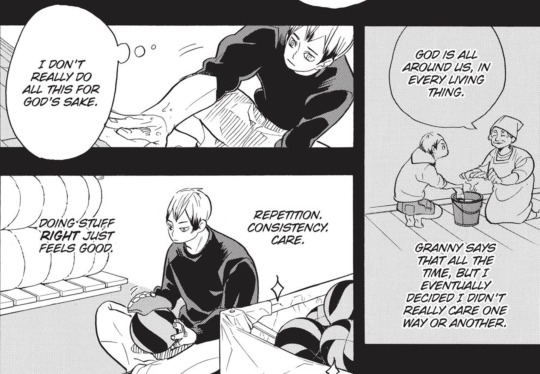
the importance of daily maintenance is something i will always think of when i see kita. he takes care of his body, cleans up, respects his traditions, and practices volleyball daily. it's a routine he follows every day without fail. to many, this seems tedious. doing the same thing everyday without a break? without fail? without anything to gain from it? most people wouldn't bother to use as much time and effort as kita does for no desired result. i'm one of the many that find it hard to keep up a routine, especially if it requires so much consistency and effort. but kita does it without complaint, without fail, and finds genuine joy in it.
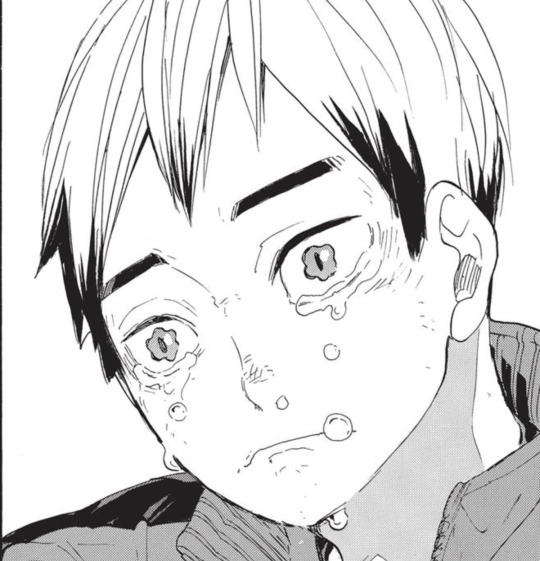
but even though kita didn't care about people's approval, the moment he was offered the captain's jersey brought him to tears. whether he cared or not, his efforts to improve himself did not go unnoticed. all that time he spent cleaning, taking care of his body, honoring tradition, and practicing volleyball led to this moment. but kita never had a goal in mind. being chosen as captain is a high achievement, but kita didn't join the team to eventually have this honor. he did what he believed was the best thing to do, and being chosen as captain was simply the result of his effort.
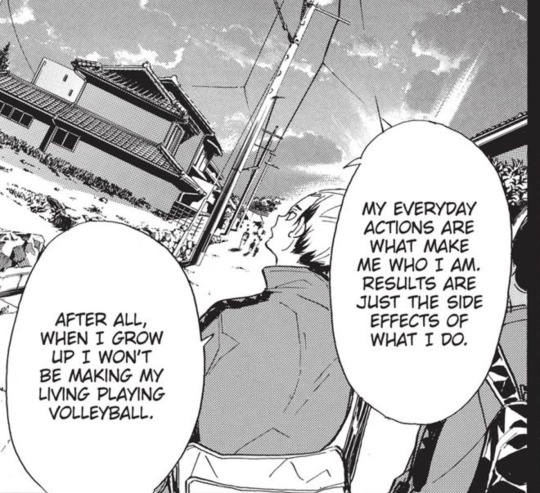
this panel changed everything for me. i even used this as my college graduation quote because i have such a heavy attachment to this scene.
kita didn't do all his daily practices to gain anything. he did them because it felt right, doing his best no matter what was more important to him.
i have a habit of always determining my worth based on the results. if i don't get a good enough grade, i see my effort as useless; if i'm not praised for something, then i feel i'm not doing my best; if all my efforts don't give me the results i want, i see my time spent as wasted but reading this scene changed everything for me.
the time you spend bettering yourself is more valuable than a result. after all, the only reason you get a good result in the first place is because of your time and dedication to your work. even though kita was emotional about his hard work being seen and rewarded, his goal wasn't to become captain. at the end of the day, he spent all this time doing things for himself.
the little things I do every day might not be valuable in the grand scheme of things; the time I spend dedicating myself to anything makes me who I am. the small, everyday things make us who we are. we care for our bodies, study or work, unwind, and prepare meals for ourselves. It doesn't lead to anything extraordinary, but it does matter. it matters because it's who we are. every little thing we do is a part of us, and the good or bad things that come with it are simply the results of what we decide to do.
kita's philosophy of doing things right because it's the right thing to do is simple, yet it's one of the lessons of haikyuu that has stuck with me the longest. we, as people, believe we need to produce results that have meaning to us, but devoting ourselves to daily tasks is essential to who we are as people and how we live our lives. we do the things we do because they are necessary, and the outcomes that follow are just byproducts.
kita is such an important character to me, and I wish this rant could do him some justice. all in all, kita shinsuke, you are the greatest philosopher of our time.
#kita shinsuke#haikyuu#hq#“my everyday actions are what make me who i am” changed my life#inarizaki#haikyuu manga#my meta
107 notes
·
View notes
Text
Deb Chachra's "How Infrastructure Works": Mutual aid, the built environment, the climate, and a future of comfort and abundance
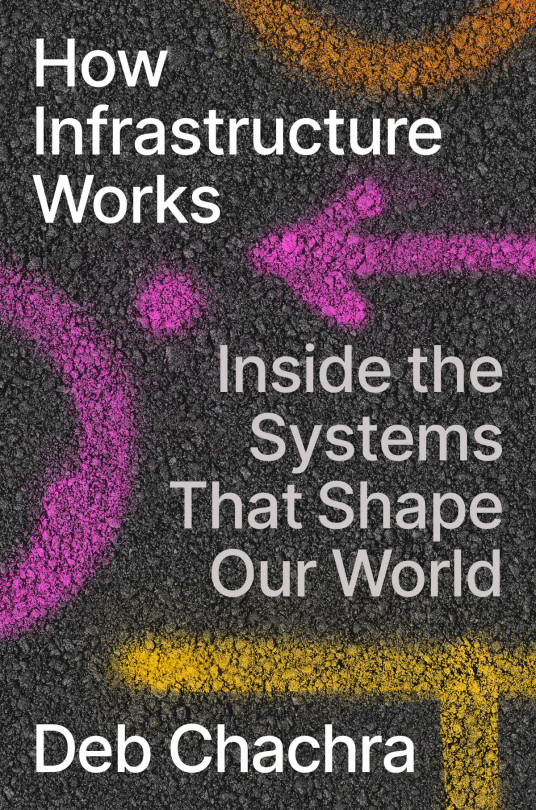
This Thursday (Oct 19), I'm in Charleston, WV to give the 41st annual McCreight Lecture in the Humanities. And on Friday (Oct 20), I'm at Charleston's Taylor Books from 12h-14h.

Engineering professor and materials scientist Deb Chachra's new book How Infrastructure Works is a hopeful, lyrical – even beautiful – hymn to the systems of mutual aid we embed in our material world, from sewers to roads to the power grid. It's a book that will make you see the world in a different way – forever:
https://www.penguinrandomhouse.com/books/612711/how-infrastructure-works-by-deb-chachra/
Chachra structures the book as a kind of travelogue, in which she visits power plants, sewers, water treatment plants and other "charismatic megaprojects," connecting these to science, history, and her own memoir. In so doing, she doesn't merely surface the normally invisible stuff that sustains us all, but also surfaces its normally invisible meaning.
Infrastructure isn't merely a way to deliver life's necessities – mobility, energy, sanitation, water, and so on – it's a shared way of delivering those necessities. It's not just that economies of scale and network effects don't merely make it more efficient and cheaper to provide these necessities to whole populations. It's also that the lack of these network and scale effects make it unimaginable that these necessities could be provided to all of us without being part of a collective, public project.
Think of the automobile versus public transit: if you want to live in a big, built up city, you need public transit. Once a city gets big enough, putting everyone who needs to go everywhere in a car becomes a Red Queen's Race. With that many cars on the road, you need more roads. More roads push everything farther apart. Once everything is farther apart, you need more cars.
Geometry hates cars. You can't bargain with geometry. You can't tunnel your way out of this. You can't solve it with VTOL sky-taxis. You can't fix it with self-driving cars whose car-to-car comms let them shave down their following distances. You need buses, subways and trams. You need transit. There's a reason that every plan to "disrupt" transportation ends up reinventing the bus:
https://stanforddaily.com/2018/04/09/when-silicon-valley-accidentally-reinvents-the-city-bus/
Even the cities we think of as motorists' paradises – such as LA – have vast, extensive transit systems. They suck – because they are designed for poor people – but without them, the city would go from traffic-blighted to traffic-destroyed.
The dream of declaring independence from society, of going "off-grid," of rejecting any system of mutual obligation and reliance isn't merely an infantile fantasy – it also doesn't scale, which is ironic, given how scale-obsessed its foremost proponents are in their other passions. Replicating sanitation, water, rubbish disposal, etc to create individual systems is wildly inefficient. Creating per-person communications systems makes no sense – by definition, communications involves at least two people.
So infrastructure, Chachra reminds us, is a form of mutual aid. It's a gift we give to ourselves, to each other, and to the people who come after us. Any rugged individualism is but a thin raft, floating on an ocean of mutual obligation, mutual aid, care and maintenance.
Infrastructure is vital and difficult. Its amortization schedule is so long that in most cases, it won't pay for itself until long after the politicians who shepherded it into being are out of office (or dead). Its duty cycle is so long that it can be easy to forget it even exists – especially since the only time most of us notice infrastructure is when it stops working.
This makes infrastructure precarious even at the best of times – hard to commit to, easy to neglect. But throw in the climate emergency and it all gets pretty gnarly. Whatever operating parameters we've designed into our infra, whatever maintenance regimes we've committed to for it, it's totally inadequate. We're living through a period where abnormal is normal, where hundred year storms come every six months, where the heat and cold and wet and dry are all off the charts.
It's not just that the climate emergency is straining our existing infrastructure – Chachra makes the obvious and important point that any answer to the climate emergency means building a lot of new infrastructure. We're going to need new systems for power, transportation, telecoms, water delivery, sanitation, health delivery, and emergency response. Lots of emergency response.
Chachra points out here that the history of big, transformative infra projects is…complicated. Yes, Bazalgette's London sewers were a breathtaking achievement (though they could have done a better job separating sewage from storm runoff), but the money to build them, and all the other megaprojects of Victorian England, came from looting India. Chachra's family is from India, though she was raised in my hometown of Toronto, and spent a lot of her childhood traveling to see family in Bhopal, and she has a keen appreciation of the way that those old timey Victorian engineers externalized their costs on brown people half a world away.
But if we can figure out how to deliver climate-ready infra, the possibilities are wild – and beautiful. Take energy: we've all heard that Americans use far more energy than most of their foreign cousins (Canadians and Norwegians are even more energy-hungry, thanks to their heating bills).
The idea of providing every person on Earth with the energy abundance of an average Canadian is a horrifying prospect – provided that your energy generation is coupled to your carbon emissions. But there are lots of renewable sources of energy. For every single person on Earth to enjoy the same energy diet as a Canadian, we would have to capture a whopping four tenths of a percent of the solar radiation that reaches the Earth. Four tenths of a percent!
Of course, making solar – and wind, tidal, and geothermal – work will require a lot of stuff. We'll need panels and windmills and turbines to catch the energy, batteries to store it, and wires to transmit it. The material bill for all of this is astounding, and if all that material is to come out of the ground, it'll mean despoiling the environments and destroying the lives of the people who live near those extraction sites. Those are, of course and inevitably, poor and/or brown people.
But all those materials? They're also infra problems. We've spent millennia treating energy as scarce, despite the fact that fresh supplies of it arrive on Earth with every sunrise and every moonrise. Moreover, we've spent that same period treating materials as infinite despite the fact that we've got precisely one Earth's worth of stuff, and fresh supplies arrive sporadically, unpredictably, and in tiny quantities that usually burn up before they reach the ground.
Chachra proposes that we could – we must – treat material as scarce, and that one way to do this is to recognize that energy is not. We can trade energy for material, opting for more energy intensive manufacturing processes that make materials easier to recover when the good reaches its end of life. We can also opt for energy intensive material recovery processes. If we put our focus on designing objects that decompose gracefully back into the material stream, we can build the energy infrastructure to make energy truly abundant and truly clean.
This is a bold engineering vision, one that fuses Chachra's material science background, her work as an engineering educator, her activism as an anti-colonialist and feminist. The way she lays it out is just…breathtaking. Here, read an essay of hers that prefigures this book:
https://tinyletter.com/metafoundry/letters/metafoundry-75-resilience-abundance-decentralization
How Infrastructure Works is a worthy addition to the popular engineering books that have grappled with the climate emergency. The granddaddy of these is the late David MacKay's open access, brilliant, essential, Sustainable Energy Without the Hot Air, a book that will forever change the way you think about energy:
https://memex.craphound.com/2009/04/08/sustainable-energy-without-the-hot-air-the-freakonomics-of-conservation-climate-and-energy/
The whole "Without the Hot Air" series is totally radical, brilliant, and beautiful. Start with the Sustainable Materials companion volume to understand why everything can be explained by studying, thinking about and changing the way we use concrete and aluminum:
https://memex.craphound.com/2011/11/17/sustainable-materials-indispensable-impartial-popular-engineering-book-on-the-future-of-our-built-and-made-world/
And then get much closer to home – your kitchen, to be precise – with the Food and Climate Change volume:
https://pluralistic.net/2021/01/06/methane-diet/#3kg-per-day
Reading Chachra's book, I kept thinking about Saul Griffith's amazing Electrify, a shovel-ready book about how we can effect the transition to a fully electrified America:
https://pluralistic.net/2021/12/09/practical-visionary/#popular-engineering
Chachra's How Infrastructure Works makes a great companion volume to Electrify, a kind of inspirational march to play accompaniment on Griffith's nuts-and-bolts journey. It's a lyrical, visionary book, charting a bold course through the climate emergency, to a world of care, maintenance, comfort and abundance.

If you'd like an essay-formatted version of this post to read or share, here's a link to it on pluralistic.net, my surveillance-free, ad-free, tracker-free blog:
https://pluralistic.net/2023/10/17/care-work/#charismatic-megaprojects


My next novel is The Lost Cause, a hopeful novel of the climate emergency. Amazon won't sell the audiobook, so I made my own and I'm pre-selling it on Kickstarter!
#pluralistic#books#reviews#deb chachra#debcha#engineering#infrastructure#free energy#material science#abundance#scarcity#mutual aid#maintenance#99 percent invisible#colonialism#gift guide
261 notes
·
View notes
Text
I like to think about what differences other races (aliens, fantasy) might have that humans are better at. Because we always seem to make ourselves the baseline and then everyone else is humans+extra attributes. Here’s a few I’ve come up with:
- Lower level of vision. They don’t consider this a handicap because that’s how ALL of them see, and the idea that we can see super sharp details is kind of perplexing. All of their technology and writing is a bit bigger than ours. They have a very hard time reading our writing because it looks like a bunch if slightly blurry patches (they like our giant lit restaurant signs). They use colors to differentiate things and are actually more attuned to color than us, with some of their letters being specific colors as well as shapes. Humans find this challenging, too, because they have to kind of lean/stand farther back to get the full scope of a word, and they can’t see all of the colors (some letters are indistinguishable from each other in shape but they are different colors).
- Slightly shorter lifespan. Not extreme or anything but maybe they only live a max 50-70 years. Some are slightly in awe of the longer-lived humans who actually have a chance of seeing 100 years; many revere such ancient humans and may even visit nursing homes to glean wisdom from the oldest living beings.
- Just big ol’ aliens who can’t fit into tiny spaces. Maybe they have hard carapaces or similar that make them less flexible. They are fascinated by how even overweight humans can often wiggle into spaces they couldn’t imagine anyone fitting into. Possibly they hire very short/thin humans for maintenance on ships as they can reach repairs that the alien would have to dismantle the whole section to fix.
- Now hear me out but I think telekinesis could have drawbacks that humans can overcome. Maybe this armless race can manipulate things with their minds, but it does take concentration. They are amazed by humans who can do some rote tasks completely on autopilot, to the point of even forgetting what they were doing. Among their race, whoever has the strongest concentration wins a tug-o-war with an object, but a human can simply pluck the object out of the air and the telekinetic can’t wrest it from their grasp. They are also fascinated by the human ability to identify texture by mere touch.
- Lower sense of smell. This race operates almost solely by sight, hearing, taste, and touch, but they barely or don’t have smell. It completely mystifies them when a human sticks its nose in the air, breathes in, and then is like, “Mmm, someone’s making pizza.” They tend to feel more at home with humans who have severe allergies and thus rarely comment about smells.
There’s a few to start! Anyone else have ideas they want to share? =D
303 notes
·
View notes
Text
I like meeting real anarchists. Anarchist do things. Things for their community, for the maintenance of every crucial aspect of their communal infrastructure. Anarchists don’t wait for the government to pave broken roads, the police to patrol the neighborhood for safety, or the messed up food industry to provide them with staple foods in times of need. We can do it ourselves. I love that.
#anarchism#anarchist#eco anarchism#eco anarchist#modern anarchism#pro gun#self sufficiency#self sufficient living
223 notes
·
View notes
Text
~ Elevator Hitch ~
What Does it All Mean!?
A brief theory on the symbolism and lore behind a really cool game

⚠️ WARNING ⚠️
This post will contain SPOILERS for the game and all 14 endings. If you wish to play Elevator Hitch before reading, you can download it for free at this link.
So, Where do we begin?
Elevator Hitch is a really cool isolated-loop surreal horror game. For those of you who aren't familiar with this concept, an "isolated-loop" is a time-loop scenario which only affects a single person, small group of people, single room, etc. — but does NOT affect the entire world or universe. This is where it's common to see things like acquiring an item in your inventory, getting murdered, then waking up again at the beginning of the day with the item still in your inventory.
This concept has been used in various different media, and to varying different degrees of complexity. But, honestly, I think this game is my favorite instance of it so far.

So our story revolves around Protag, a somewhat meek and nervous lil guy who comes to this office building to take an interview for a new job. All he knows is that his interview isn't on the first floor, so he gets in the elevator in an attempt to find it. Before the door closes, Coworker forces his way in, and the elevator suddenly shorts out and jams before you two can begin your journey. The rest of the game is your various attempts to exit the elevator (alive) which get increasingly bizarre — especially after Protag realizes that whenever he dies, time restarts to when they first entered the elevator!
Shame Coworker doesn't seem to remember anything, though...
Now, since the lore within the game is pretty cryptic, none of our questions about the situation ever seem to get totally answered. It's up to the player to theorize and surmise just what exactly is happening to Protag and Coworker, and that's exactly what I've come here to do.

Death and Clues on Every Floor...
Literally! Every floor is a single room containing at least 1 clue, and at least 1 possible death — including the elevator itself. But what's even more important than that is the lore that all of these scenes show you.
Interestingly enough, the lore all seems to revolve around who Protag is as a person, to the point that one of the floors is actually his childhood bedroom.
Kind of intriguing that everything about this environment is centered around him, huh?
Hold onto that thought.

Every room and scenario is increasingly more bizarre, featuring anything from Eldritch-esque beings to settings that could almost pass for torture chambers. Every puzzle requires something from a different floor, making it ridiculously easy to screw up and croak, meanwhile Coworker is so maddeningly unaware that even when he tries to offer advice it's just as cryptic as the situation itself.
It all feels a lot... Like Hell...
Not just as an expression, but actual Hell. Mind rending stimuli navigated through tedious puzzle solving, where the penalty is gruesome death and the only reward is more torture. A neverending loop of suffering and confusion. It's all quite hellish!
At first this feels a bit superficial. "Of course it's hellish, this is a horror game!" But, honestly, good horror like this game is rarely ever bizarre and incomprehensible for the sheer shock value. If all of these allusions were superficial, why would we have such a detailed and cryptic conversation with Manuel, the maintenance worker?
Why would every single "correct answer" to the puzzles have sinister undertones?
Why would the religious subtext in Protag's room be so subtle and yet so distinct at the same time?
So if we humour ourselves and follow this train of thought then that leads one to wonder...

Why would Protag be in Hell?
Good question! After all, he doesn't even seem to be aware of having any initial death!
But, we are given breadcrumbs to what sort of person Protag is through the various different scenarios that ensue. Some things are minor details, like his lack of remorse for feeding an innocent rat to a hungry black hole. Others are more intense and significant, like the clues in his bedroom...
Let's start with pointing out the obvious direction that Protag's dialogue trees nudge you in.
After all, this game is a visual novel, so of course there are points when your dialogue options matter and can very well change the outcome of the situation. However, most VNs have options that are distinctly "good" or "bad" for the story directions, often leading the player on a journey of teaching the protagonist how to be a better person.
But Protag.... doesn't become better...
All of his dialogue options are either:
• Confusion, Frustration, Disbelief
• Self-Deprecating, Meek
• Deceptive
• Lashing Out
Obviously some of these options are better for certain scenarios. Deceiving Coworker into giving you his lighter is a way better idea than trying to steal it and burning you both to death.
And deceiving your Doppelgangers into trusting you before your brutal betrayal is arguably better than trusting them and getting betrayed in return.
But none of these options point to Protag being a good person. As much as he learns to adapt to his environment, nothing he does teaches him how to be a better person than he started out as. In fact, some of them even lead him to commit murder himself!

Of course, this isn't saying that Protag is necessarily a bad person either. After all, his initial reaction to the Doppelgangers is to trust them and even show them pity.
We also get a lot of information about Protag from the floor that mimics his childhood bedroom. He was monitored constantly by overbearing and religious parents, to the point that one of the Bad Ends is his parents entering the room.
He couldn't sleep, plagued by nightmarish beings which he even made drawings of, and had to take sleeping pills just to cope (which may or may not have been hidden from his parents as well)
Considering this, and just the sheer amount of existential dread Protag has upon visiting this floor, it's very possible that his parents were abusive. His personality issues are probably a result of that abuse, meaning even though he isn't necessarily a good person, he also isn't inherently a bad one.
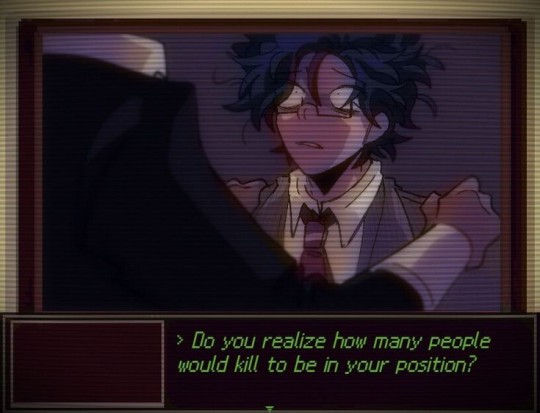
The Allusions of Suicide...
This should honestly come as no surprise, but this game does have a lot of potential allusions to suicide. Especially when taking into account what suicide means in Christianity...
I first noticed this in the dialogue on Floor 9 with Normal Guy, as well as the dialogue contained in Ending 13 (screenshot above). During the interview on Floor 9, Protag seems to struggle with answering most of the questions. When asked why he wanted a new job, all of the answers imply that he doesn't actually know why, and when asked why he left his old job, Protag states that "it wasn't a Real Job" or at least not one viewed as respectable.
Then, when attempting to leave the Lobby on Floor 1, Protag is blocked by an alarming figure who berates him. The figure taunts Protag with phrases he's likely told himself, like "you worked so hard to get here" and especially "you NEED this job"
Now, this game absolutely LOVES its workplace puns, and something about these ones just struck me as significant. Upon further reflection on everything going on, I realized that these phrases are almost synonymous with suicidal thoughts.
As someone who's experienced this myself, I understand that a lot of suicidal thoughts are rooted more in the desire for change, and not the desire for death. So consider this...
Protag isn't looking for a new job, he's looking for a new life. His old life didn't feel "real" or "respectable", likely because of whatever abuse he endured from his parents. After all, his childhood bedroom is described by him as his "old place", meaning he likely was living with his parents until somewhat recently.
So then when he finally passes the interview — passes this hellish elevator trial of self-discovery — and tries to flee, he's stopped by the thoughts of regret for taking his own life.
"You worked so hard for this new life, why are you throwing it away?"
"You NEED this change."
"You can't go back to what you were before."
Then there's the Sleeping Pill found in Protag's bedroom. It's not found in a pill bottle or any other typical storage, but rather it's under the bedsheets. This gives the impression that the pill either fell out of Protag's hand in bed, or that he was hiding the pills from his overbearing parents.
Then there's the fact that sleeping pills are a very common medium for attempted suicide.
This leads me to suspect that Protag either overdosed in an attempted suicide as a child, causing his parents to become even more protective.
Or... This is how Protag ended up at the office building in the first place...
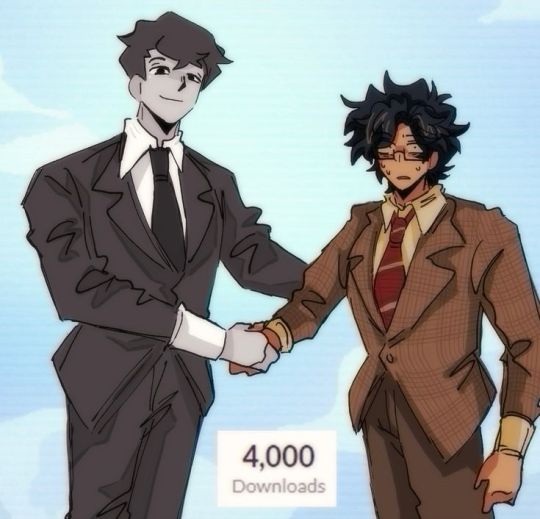
Welcome to Protag's Purgatory
Yeah, you may have guessed it already, but I am in fact suggesting that Protag has committed suicide and is currently trapped in Purgatory. After all, if you consider the distinct hint at his religious background, it's not unlikely to be following the Christian belief that suicide will condemn you to Purgatory. In fact, the opening of the game, where Protag feels like the only one who doesn't know where he's going, is a reference to the nature of Purgatory.
Consider, also, the nature of the game. Everything you do in it is a sort of trial, and it all tests the nature of Protag's true self. Not to mention that Purgatory is an unchanging limbo, just as the game paints a picture of an unending time-loop on repeat.
Protag took his own life, and his penance is to be trapped in an unending trial of self-discovery. Floor 9 resembles Heaven, like Cloud 9, where Protag is administered one final test. Normal Guy gives Protag the option to have become a better person, and possibly pass on to a better afterlife, however our dialogue tree tells us that Protag hasn't reached that level of self acceptance yet.
Therefore, the only options are what appears to be working in Purgatory (possibly like Manuel), enduring the trial over and over again, or as hinted by the eerie staircase downward in Ending 14, descent into Hell...
You're probably wondering if this theory accounts for Coworker, and it certainly does. After all, he seems rather unperturbed by the events he's undergone. I suspect he also committed suicide, but didn't have the same background of religious guilt that Protag had growing up. Coworker knows that he's supposed to go to the top, that he's supposed to pass on. He's at peace with who he is and where he's going, therefore he doesn't endure the same personal torture that Protag does.
No matter what ending you get in Elevator Hitch, nothing truly changes for Protag, because he himself hasn't changed. It's possible that there is some sort of future where Protag can change and move on — in fact, Normal Guy even hints that speaking to Coworker more could be the key to his salvation — but this possible future is one we will never see.
Because that's not the point of the game. The point is to become immersed in the torture which Protag goes through, and to try and unravel the mysteries of who he is and what he's enduring.
So there's my thoughts on the game. I hope you all enjoyed reading, and I'd love to hear any comments or input you have!
#elevator hitch#studio investigrave#racheldrawsthis#indie horror game#game theories#analysis#itch.io#elevator hitch protag#coworker elevator hitch#normal guy#this took two days to write help
79 notes
·
View notes
Text
As someone who used to identify as aromantic, I used to (and still do) struggle to differentiate between romantic and platonic attraction, here's my best explanation.
It's very similar to platonic attraction. You want to spend a lot of time with a person, you want to get to know them, you want to express affection for them.
The difference is in the intensity of it. With romantic attraction, you want to know their deepest secrets and show your affection for them RIGHT NOW. The feelings of love and attachment to this person are overwhelming and powerful clouders of judgement, especially at the onset of a crush or the start of a new relationship.
For the asexuals, this is why romantic and sexual attraction are perceived to be the same thing for most people, because sex is often thought of as the highest form of intimacy; it's a very intense, vulnerable, and physically close form of physical affection. But regardless of whether sex is a factor, the basis of romance is the desire to connect with someone as intimately and as quickly as possible.
Another difference is the duration of it. Feelings of friendship are generally very consistent, and can last long periods of time with less maintenance on the relationship itself. However, feelings of romantic attraction, while strong, are more short-lived. After the "honeymoon stage" of a relationship is over, the powerful, intoxicating feelings start to dissipate, and the lovers face a choice:
break up because the loss of the feeling means you're not motivated to keep the relationship going anymore
stay together and resign themselves to a more comfortable, platonic dynamic (I say "resign" not to mean that it's lesser than a passionate romance, just not as dramatic)
keep rekindling the fire, keep finding new ways to express affection or new things to discover about each other
When I explained it to myself in this way, it helped me understand why there are so many seemingly nonsensical rituals and customs surrounding dating and relationships: it's an attempt to regulate it. Romantic attraction is a very volatile feeling; it's strong, it blocks off your rationality, and it doesn't last a long time with the same person if you don't know how to keep it up. This means it has the potential to cause a lot of strife and maybe cause physical pain if there are no rules of engagement (engagement lol, pun not intended). So we have practices of dates, and marriage, and social mores about how to interact with each other in order to pace ourselves.
This is how I interpret it, at least. Other allos, feel free to add your own perspectives or shit on mine if yours is completely different. I'm still young, so my view on it is probably immature, but I think it's a good basis for future conversation, at least.
For the aros reading this, I hope it was helpful!
#aromantic spectrum#aromanticism#asexual#aromantic#lgbtq#queer#gay pride#gay#lesbian#bisexual#transgender#nonbinary#pansexual
61 notes
·
View notes